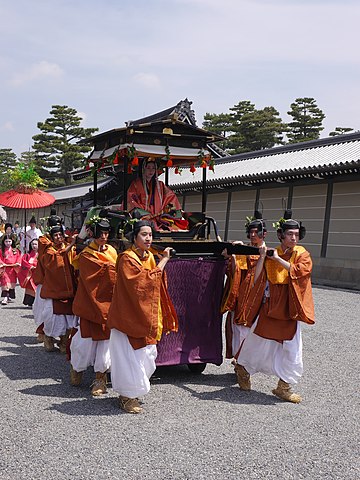The Aoi Matsuri, also known as the Hollyhock Festival, is one of Kyoto’s three most famous festivals, along with the Gion Matsuri and the Jidai Matsuri. It is a historic event that dates back over a thousand years and is known for its elaborate, traditional ceremonies and vibrant procession. Let’s uncover the secrets and highlights of the Aoi Matsuri:
1. Historical Roots:
The Aoi Matsuri has its origins in the Heian period (794-1185). It was established as a purification ritual to appease the deities after a period of illness and misfortune in the capital.
2. Date and Location:
The festival is held on May 15th each year. The main events take place at two of Kyoto’s most famous historical sites, the Kyoto Imperial Palace and the Shimogamo Shrine.
3. Aoi Symbolism:
The festival derives its name from the aoi (hollyhock) plant, which is the emblem of the event. Participants, including horses and carriages, are adorned with hollyhock leaves and flowers.
4. Elaborate Traditional Clothing:
One of the key features of the Aoi Matsuri is the intricate and historically accurate costumes worn by the participants. Court nobles, including the Emperor and Empress, wear traditional Heian-era attire, complete with layered kimono, hakama, and formal court caps.
5. Procession of Elegance:
The main event is the grand procession that moves from the Kyoto Imperial Palace to the Shimogamo Shrine. The parade includes noblewomen, noble courtiers, priests, and Shinto maidens, all in regal Heian-era attire.
6. Horse Procession:
Horses play a significant role in the Aoi Matsuri, with mounted guards and nobles riding in procession, evoking the elegance of the Heian period.
7. Precise Protocol:
The festival adheres to strict court protocols and rituals, aiming to recreate the atmosphere of the Heian court. These rituals are followed with great attention to detail.
8. Traditional Music and Dance:
The procession is accompanied by traditional music and dance, including gagaku (court music) and bugaku (court dance), adding to the historical and cultural richness of the event.
9. Shimogamo Shrine Rituals:
The procession concludes at the Shimogamo Shrine, where a series of Shinto rituals are performed to purify the city and its residents.
10. Public Participation:
While the core of the Aoi Matsuri is the solemn court procession, the event is open to the public, who can observe the rituals, enjoy the historic atmosphere, and witness the beauty of the Heian period recreated in the 21st century.
The Aoi Matsuri is a captivating journey back in time to the elegance and refinement of Japan’s Heian period. It is a living museum of historical courtly traditions, celebrated in the modern era for its cultural significance and meticulous attention to detail.










